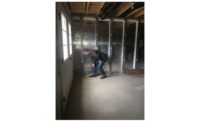For wall and ceiling contractors, implementation of the energy code will have a dramatic effect on the construction of exterior wall assemblies. No longer will insulating the exterior walls simply consist of installing an R-30 batt insulation between studs. Batt insulation helps to insulate the wall but does nothing to prevent the heat loss from window systems and little to compensate for the thermal break from light gauge metal studs.
The Goals of CI
One of the primary goals of the energy code is to take measures to prevent the loss of heat from the building structure. To meet the new energy code, buildings will have to achieve a U-factor predicated upon their specific region/climate zone. A U-factor is a rating based on how much heat loss a system allows. U-factors generally range from 0.2 (very little heat loss) to 1.2 (high heat loss). The U-factor is the inverse of the R-value, which measures insulating value. One of the most effective means of achieving a low U-factor and minimizing heat loss from thermal conductivity in the wall assembly is by installing continuous insulation outboard of the metal studs or sheathing.
“Continuous insulation” is an insulation that is continuous across all structural members without thermal bridges other than fasteners (i.e., screws and nails) and service openings. It is installed on the interior or exterior wall system or is integral to any opaque surface of the building envelope. Insulation installed between metal studs, z-girts, z-channels, shelf angles, or insulation with penetrations by brick ties and offset brackets, or any other similar framing, is not considered continuous insulation, regardless of whether the metal is continuous or occasionally discontinuous or has thermal break material.
The challenge, of course, is how to incorporate CI with exterior claddings. One-coat and even traditional three-coat stucco assemblies have, over the years, incorporated rigid foam insulations. The Northwest Wall and Ceiling Bureau has recognized the benefits of foam insulation and stucco assemblies and provides information in Technical Document 600-615. The Western Conference of Wall and Ceiling Institutes and the Technical Services Information Bureau (TSIB) in Southern California have been at the forefront of CI and stucco assemblies and provide comprehensive information and detailing in the brochure “The Energy Code and Plaster Assemblies” (www.tsib.org) for both stucco and EIFS assemblies.
The Ideal CI System
In addition to stucco over CI, we really don’t have to look very far to find the perfect cladding to meet the new energy code: It is EIFS.
One of the primary benefits of EIFS claddings has always been the energy efficiency of the system. Now, with the code mandated energy requirements and the improvements made over the years (drainable EIFS with a fluid-applied water resistive barrier), we should begin to see a significant resurgence of EIFS claddings. This is not going to be without its challenges. There are a lot of owners and architects out there that seem to want to live in the past. Instead of recognizing the energy code advantages of EIFS and simply asking, what steps have been taken to improve EIF systems and eliminate the problems of the past, they still choose not to entertain the use of EIFS. It makes you wonder where the world would be if, rather than improving on systems that experienced certain challenges, we chose instead to “throw the baby out with the bath water.”
Perfection is not achieved by giving up—it is achieved by working through the problems and challenges that we face and making improvements to those systems that could very well provide the logical answer to specific demands. Let’s open our minds and take another look, I am certain that you will see that the logical answer to meeting the energy code requirements for a CI finish system is the vastly improved exterior insulation finish system.








Report Abusive Comment